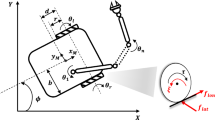Abstract
The Sliding Mode Control (SMC) is a widely spread approach thanks to its efficiency and robustness. However, it suffers from the undesirable chattering phenomenon which leads to the mechanical system damage. Then, this study takes into consideration the second order SMC which is known by its reliability regarding disturbances and nonlinear uncertainties, in order to improve the system stability and performances. In fact, such a high order SMC ensures a trade off between chattering reduction and disruption resistance. First, a second order sliding mode controller has been elaborated. Then, and in order to test the robustness of the proposed strategy, a measurement noise has been introduced. Simulation results show the efficiency of the proposed second order SMC applied to a robot manipulator system in a motion control task, which is used to ensure the displacement of a surveillance camera.
Access this chapter
Tax calculation will be finalised at checkout
Purchases are for personal use only
Similar content being viewed by others
References
Chen M, Chen WH (2010) Sliding mode control for a class of uncertain nonlinear system based on disturbance observer. Int J Adapt Control Signal Process 24:51–64
Sira-Ramirez H (1992) On the sliding mode control of nonlinear systems. Syst Control Lett 19:303–312
Gao W, Wang Y, Homaifa A (1995) Discrete-time variable structure control systems. IEEE Trans Ind Electron 42:117–122
Shtessel Y, Edwards C, Fridman L, Levant A (2014) Introduction: intuitive theory of sliding mode control. In: Sliding mode control and observation. Springer, New York, pp 1–42
Vaidyanathan S, Azar AT (2015) Hybrid synchronization of identical chaotic systems using sliding mode control and an application to Vaidyanathan chaotic systems. Stud Comput Intell 576:549–569
Piltan F, Sulaiman N, Marhaban MH (2011) Design of FPGA based sliding mode controller for robot manipulator. Int J Robot Autom 2:183–204
Xu L, Yao B (2001) Adaptative robust precision motion control of linear motors with negligible electrical dynamics: theory and experiments. IEEE Trans Mechatron 6:444–452
Shafiei SE (2010) Sliding mode control of robot manipulators via intelligent approaches. INTECH Open Access Publisher
Perruquetti W, Barbot JP (2002) Sliding mode control in engineering. CRC Press Publisher
Levant A (2010) Chattering analysis. IEEE Trans Autom Control 55:1380–1389
Vaidyanathan S (2016) Anti-synchronization of 3-cells cellular neural network attractors via integral sliding mode control. Int J PharmTech Res 9:193–205
Kapoor N, Ohri J (2013) Integrating a few actions for chattering reduction and error convergence in sliding mode controller in robotic manipulator. Int J Eng Res Technol 2
Vaidyanathan S (2015) Global chaos synchronization of 3-cells cellular neural network attractors via integral sliding mode control. Int J PharmTech Res 8:118–130
Vaidyanathan S (2015) Global chaos control of 3-cells cellular neural network attractor via integral sliding mode control. Int J PharmTech Res 8:211–221
Golea N, Debbache G, Golea A (2012) Neural network-based adaptive sliding mode control for uncertain non-linear mimo systems. Int J Model Ident Control 16:334–344
Kapoor N, Ohri J (2013a) Fuzzy sliding mode controller (FSMC) with global stabilization and saturation function for tracking control of a robotic manipulator. J Control Syst Eng 1:50
Slotine JJE, Li W (1991) Applied nonlinear control. Prentice Hall, Englewood Cliffs, NJ
Zinober ASI, ElGhezawi OE, Billings SA (1982) Multivariable structure adaptive model following control systems. IEE Proc D (Control Theor Appl) IET Digital Libr 129:6–12
Vaidyanathan S (2016) Global chaos regulation of a symmetric nonlinear gyro system via integral sliding mode control. Int J ChemTech Res 9:462–469
Fridman L, Levant A (2002) Higher order sliding modes. Sliding Mode Control Eng 11:53–102
Vaidyanathan S (2016) A highly chaotic system with four quadratic nonlinearities, its analysis, control and synchronization via integral sliding mode control. Int J Control Theory Appl 9:279–297
Vaidyanathan S, Sampath S (2016) A novel hyperchaotic system with two quadratic nonlinearities, its analysis and synchronization via integral sliding mode control. Int J Control Theory Appl 9:221–235
Bartolini G, Pydynowski P (1996) An improved, chattering free, VSC scheme for uncertain dynamical systems. IEEE Trans Autom Control 41:1220–1226
Bartolini G, Ferrara A, Usani E (1998) Chattering avoidance by second-order sliding mode control. IEEE Trans Autom Control 43(2):241–246
Ferrara A, Magnani L (2007) Motion control of rigid robot manipulators via first and second order sliding modes. J Intell Robot Syst 48:23–36
Abdelhedi F, Bouteraa Y, Derbel N (2014) Distributed second order sliding mode control for synchronization of robot manipulator. In: Second international conference on automation, control, engineering and computer science
Vaidyanathan S, Sampath S (2016) Hybrid synchronization of identical chaotic systems via novel sliding control method with application to Sampath four-scroll chaotic system. Int J Control Theory Appl 9:321–337
Vaidyanathan S, Sampath S (2016) Anti-synchronization of identical chaotic systems via novel sliding control method with application to Vaidyanathan-Madhavan chaotic system. Int J Control Theory Appl 9:85–100
Vaidyanathan S, Sampath S, Azar AT (2015) Global chaos synchronisation of identical chaotic systems via novel sliding mode control method and its application to Zhu system. Int J Model Ident Control 23:92–100
Author information
Authors and Affiliations
Corresponding author
Editor information
Editors and Affiliations
Rights and permissions
Copyright information
© 2017 Springer International Publishing AG
About this chapter
Cite this chapter
Fathallah, M., Abdelhedi, F., Derbel, N. (2017). Insensibility of the Second Order Sliding Mode Control via Measurement Noises: Application to a Robot Manipulator Surveillance Camera. In: Vaidyanathan, S., Lien, CH. (eds) Applications of Sliding Mode Control in Science and Engineering. Studies in Computational Intelligence, vol 709. Springer, Cham. https://doi.org/10.1007/978-3-319-55598-0_5
Download citation
DOI: https://doi.org/10.1007/978-3-319-55598-0_5
Published:
Publisher Name: Springer, Cham
Print ISBN: 978-3-319-55597-3
Online ISBN: 978-3-319-55598-0
eBook Packages: EngineeringEngineering (R0)




